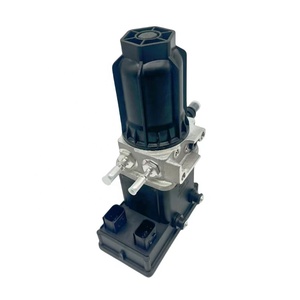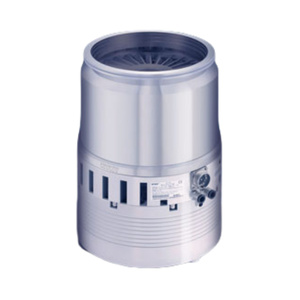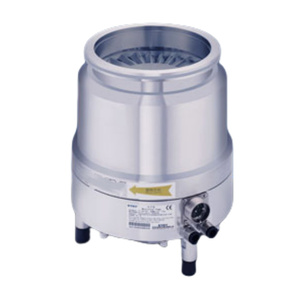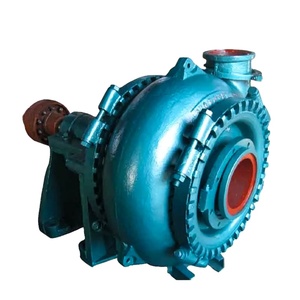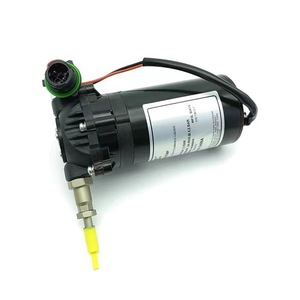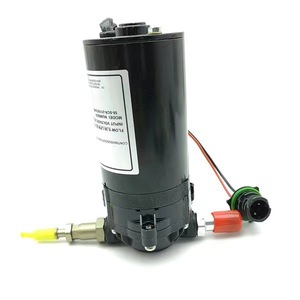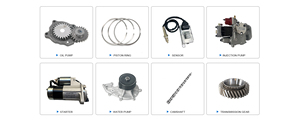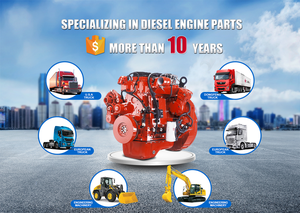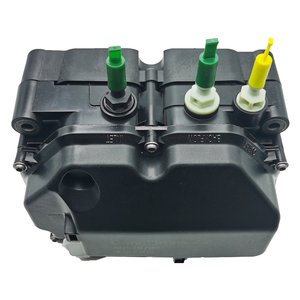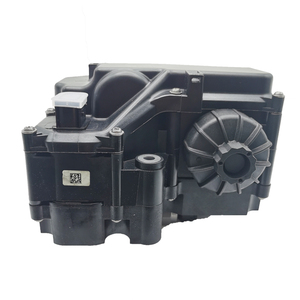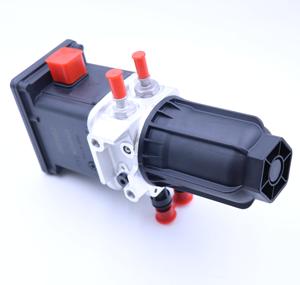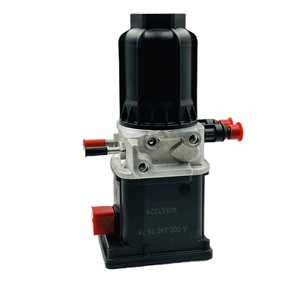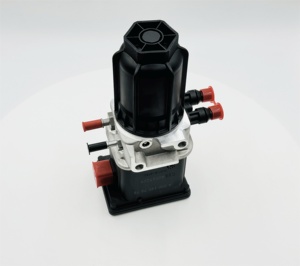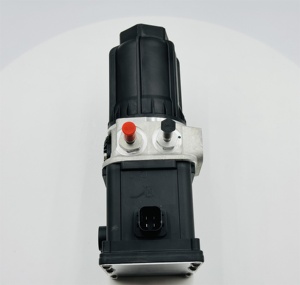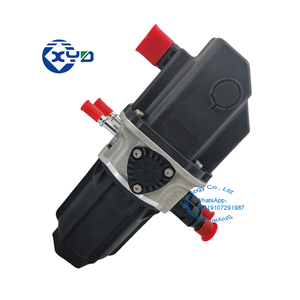Types of SCR Urea Pumps
SCR Urea Pump systems are vital components in modern diesel engines, particularly in heavy-duty trucks. Their primary function is to reduce nitrogen oxide emissions, helping vehicles meet stringent environmental regulations. These pumps inject a urea-water solution (commonly known as DEF - Diesel Exhaust Fluid) into the exhaust system, where it reacts with nitrogen oxides in the presence of a catalyst. This chemical reaction transforms harmful nitrogen oxides into harmless nitrogen gas and water vapor, significantly reducing emissions.
Understanding the Importance: Without a properly functioning SCR Urea Pump, the entire Selective Catalytic Reduction system cannot operate effectively. This leads to increased emissions, potential system damage, vehicle performance issues, and non-compliance with emission standards set by regulatory bodies.
Electric Motor Pump
The most common choice for SCR systems due to reliability and low maintenance requirements.
Key Features:
- Consistent pressure and flow delivery
- High reliability in various operating conditions
- Precise control over urea injection rates
Selection Tips: Match pump pressure/flow to SCR requirements; choose corrosion-resistant materials; ensure reliable seals to prevent leaks.
Diaphragm Pumps
Positive displacement pumps using a flexible diaphragm to separate pumping and actuator chambers.
Key Features:
- No fluid contamination risk
- Excellent for corrosive urea solutions
- Wide range of flow rates and pressures
Selection Tips: Choose urea-compatible diaphragm materials (EPDM/PTFE); ensure corrosion-resistant components; verify flow rate matches SCR needs.
Gear Pumps
Rotary positive displacement pumps utilizing interlocking gears to move fluid.
Key Features:
- High efficiency and accuracy
- Excellent for high-pressure applications
- Compact, durable design
Selection Tips: Determine required flow rate and pressure; ensure all materials (gears, housing) are urea-compatible.
Peristaltic Pumps
Special pump type that uses rollers to compress a tube in sequence, creating peristaltic fluid movement.
Key Features:
- Precise dosing and metering
- No internal pump contamination
- Low maintenance requirements
Selection Tips: Determine flow accuracy needs; select urea-compatible tubing materials (nitrile/silicone); ensure design allows proper compression/relaxation.
| Pump Type | Best For | Advantages | Disadvantages | Typical Applications |
|---|---|---|---|---|
| Electric Motor Pump | Most SCR systems | Reliable, precise control, low maintenance | Higher power consumption | Heavy-duty trucks, buses, large machinery |
| Diaphragm Pump | Systems requiring isolation | No fluid contamination, handles corrosive solutions | Diaphragm replacement eventually needed | Industrial vehicles, specialized equipment |
| Gear Pump | High-pressure applications | Efficiency, accuracy, durability | Can be damaged by particulates | Precision dosing systems, high-performance vehicles |
| Peristaltic Pump | Precise metering needs | Accurate dosing, minimal maintenance | Tube wear over time | Specialty vehicles, advanced emission control |
Specifications and Maintenance of SCR Urea Pumps
Understanding the key specifications and maintenance requirements of SCR urea pumps is essential for optimal performance and longevity. Here are the critical specifications typically found in user manuals:
Flow Rate
The volume of urea solution transported per unit time, typically measured in liters per hour.
Typical Range: 20-200 liters/hour
Importance: Determined by vehicle size and emission control requirements
Pressure
The force required to move the urea solution through the system, measured in bar.
Typical Range: 1-5 bar
Importance: Must be sufficient to deliver solution from storage tank to injection point
Temperature Range
The operational temperature limits for effective pump function.
Typical Range: -40°C to 120°C
Importance: Critical as urea crystallizes at low temperatures and decomposes at high temperatures
Materials
Construction materials that resist the corrosive properties of urea solution.
Common Materials: Stainless steel, specialized plastics, ceramic components
Importance: Enhances durability, reliability, and minimizes maintenance costs
Essential Maintenance Practices
Proper maintenance ensures optimal performance, extends pump lifespan, and prevents costly repairs. Follow these maintenance recommendations:
| Maintenance Task | Frequency | Procedure | Importance |
|---|---|---|---|
| Regular Inspection | Monthly or during scheduled vehicle maintenance | Visual inspection of housing, seals, bearings, and impeller; check for leaks or unusual noises | Early problem identification prevents major failures |
| Seals and Gaskets Replacement | When showing signs of wear or every 2 years | Remove old seals/gaskets, clean surfaces, install new components | Prevents leakage and system contamination |
| Impeller and Housing Check | Every 6-12 months | Inspect for wear, damage, or cracks; replace if necessary | Ensures proper pump function and prevents complete failure |
| Cleaning | Every 3-6 months | Clean with soft cloth and mild detergent; remove debris and buildup | Prevents efficiency loss from contaminant buildup |
| Lubrication | According to manufacturer's schedule | Apply appropriate lubricant to bearings and drive shaft | Reduces friction, minimizes wear on moving components |
Maintenance Tip: Keep a maintenance log for your SCR urea pump to track service history, identify recurring issues, and ensure scheduled maintenance is performed on time. This documentation can be valuable for warranty claims and helps establish patterns that might indicate system problems.
How to Choose an SCR Urea Pump
Selecting the right SCR urea pump for your vehicle requires careful consideration of several factors. Making an informed choice ensures proper system function, compliance with emission standards, and long-term reliability.
Vehicle Compatibility
The most critical selection factor is ensuring the pump matches your specific vehicle.
- Identify make, model, and production year
- Verify engine specifications and SCR system type
- Check OEM part numbers for exact matching
Warning: Using an incompatible pump can damage the exhaust system and void warranties
Brand Consideration
The pump manufacturer's reputation directly impacts reliability and performance.
- Research brands with strong automotive industry presence
- Check for industry certifications and quality standards
- Review customer experiences and reliability reports
Recommendation: Premium brands often provide better durability and support
Warranty & Support
Protection against defects provides peace of mind and potential cost savings.
- Look for minimum 1-year warranty coverage
- Check for money-back guarantees
- Verify availability of technical support
Tip: Longer warranties often indicate manufacturer confidence in product quality
Budget Considerations
Balancing cost with quality ensures good value without compromising performance.
- Compare prices across reputable sellers
- Consider total cost including installation if not DIY
- Factor in potential longevity differences
Advice: Invest in quality to avoid frequent replacements
| Selection Factor | What to Look For | Why It Matters |
|---|---|---|
| Technical Specifications | Flow rate, pressure rating, temperature range that match vehicle requirements | Ensures proper SCR system function and emission control |
| Material Quality | Corrosion-resistant components, quality seals and gaskets | Determines longevity, especially given urea's corrosive properties |
| Installation Complexity | Ease of installation, included hardware, clear instructions | Affects DIY feasibility and potential professional installation costs |
| Customer Reviews | Feedback on durability, ease of installation, performance | Provides real-world experience from other users with similar vehicles |
| Dealer/Supplier Reputation | Return policy, support resources, authenticity guarantees | Protection against counterfeit products and support if issues arise |
Important Warning: Be wary of unusually cheap SCR urea pumps. Counterfeit or low-quality pumps may initially save money but often lead to poor performance, system damage, and potentially costly repairs. Always verify the pump's authenticity and ensure it meets manufacturer specifications.
How to DIY and Replace SCR Urea Pump
Replacing an SCR urea pump can be completed as a DIY project with the right preparation and approach. Follow these steps carefully to ensure a successful replacement:
Before You Begin: Read the vehicle manufacturer's instructions thoroughly. Different vehicles have different SCR system configurations. Gather all necessary tools and replacement parts before starting the process. Working in a well-ventilated area is recommended as DEF has a strong ammonia odor.
Step 1: Preparation and Location
- Ensure the vehicle is parked on level ground with the engine off
- Disconnect the battery to prevent electrical issues
- Locate the SCR system and urea pump (typically connected to the urea tank)
- Prepare a container to collect any urea solution that may spill
Safety Note: Wear gloves and safety goggles to protect yourself from urea solution, which can cause irritation.
Step 2: Draining and Disconnection
- Drain the urea solution from the tank into an appropriate container
- Carefully disconnect the urea lines (be prepared for some residual solution)
- Disconnect all electrical connections to the pump (take photos first to remember placement)
- Label all connections if necessary to ensure correct reassembly
Tip: Take clear photos of all connections before disconnecting for reference during reassembly.
Step 3: Removal and Installation
- Remove mounting bolts or fasteners securing the old pump
- Carefully remove the old pump, noting its orientation
- Install the new pump in the same orientation
- Secure all mounting bolts to the manufacturer's torque specifications
Important: Never force components together. If you encounter resistance, verify alignment and try again.
Step 4: Reconnection and Testing
- Reconnect all electrical connections and urea lines
- Ensure connections are secure and properly sealed
- Refill the urea tank with fresh DEF solution
- Reconnect the battery
- Start the vehicle and check for error codes using a diagnostic tool if available
- Verify no leaks are present in the system
Final Check: Allow the vehicle to run for several minutes to ensure the SCR system functions properly.
Important Safety Notes:
- Always dispose of the old pump and any urea solution according to local environmental regulations
- Use only approved DEF solution in the system - never substitute with other fluids
- If you encounter any unusual resistance or complications during the process, consult a professional
- Some vehicles may require system priming or computer reset after pump replacement - check your vehicle's service manual
Post-Installation Recommendation: After replacing the SCR urea pump, monitor the system for a few days. Check for any warning lights, unusual operation, or leaks. Many issues appear only after several operating cycles, so vigilance during the initial period following replacement is essential.
Frequently Asked Questions
The typical lifespan of an SCR urea pump ranges from 120,000 to 200,000 miles. However, this can vary significantly based on:
- Quality of the pump and its components
- Driving conditions and habits (stop-and-go vs. highway driving)
- Vehicle type and engine specifications
- Quality of DEF solution used
- Maintenance practices and frequency
Regular system checks during routine maintenance can help identify early signs of pump wear and prevent unexpected failures.
No, it is never acceptable to use distilled water in place of proper Diesel Exhaust Fluid (DEF). SCR systems require a precise chemical formulation of:
- 32.5% high-purity urea
- 67.5% deionized water
This exact solution (meeting ISO 22241 standards) is necessary for the proper chemical reaction within the catalytic converter. Using distilled water or any other substitute will:
- Prevent proper NOx reduction
- Potentially damage the SCR system components
- Void the vehicle warranty
- Likely trigger fault codes and reduced engine performance
Always use commercially available DEF that meets the required specifications.
In most cases, complete replacement of a malfunctioning urea pump is recommended rather than repair. This is because:
- Internal components are often difficult to access and precisely reassemble
- The pump's exposure to corrosive urea solution typically causes multiple component degradation
- Diagnosing the exact failure point is challenging without specialized equipment
- The cost of professional repair often approaches or exceeds replacement cost
- Replacement ensures all components are new and properly calibrated
Some specialized repair shops may offer rebuild services for certain pump models, but this is generally less common and may not restore full functionality or reliability.
While the urea pump itself is designed to be relatively low-maintenance, regular system checks are important:
- Visual inspection during routine vehicle maintenance (every 10,000-15,000 miles)
- Checking for leaks or crystallization around connections
- Monitoring for unusual noises during operation
- Ensuring DEF quality by using fresh solution and maintaining a clean tank
- Following manufacturer-specific maintenance schedules in your vehicle manual
Preventative maintenance significantly extends pump life and helps avoid unexpected failures that could lead to vehicle downtime or reduced performance.
No, urea pumps are designed specifically for vehicles with diesel engines that use Selective Catalytic Reduction (SCR) technology, typically those meeting:
- Euro 5 and Euro 6 emission standards in Europe
- EPA 2010 and later standards in the United States
Additionally, pumps are designed for specific vehicle applications:
- Each vehicle manufacturer uses unique mounting configurations
- Flow rates and pressure specifications vary by engine size and type
- Electrical connectors and control systems differ between manufacturers
- Physical dimensions must match the installation space
Always verify compatibility with your specific vehicle make, model, and year before purchasing a replacement pump.



